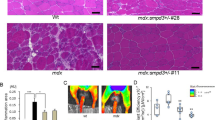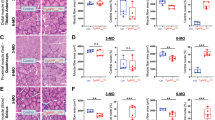Abstract
Duchenne muscular dystrophy (DMD) is a neuromuscular disorder that affects muscles and also the brain, resulting in memory and behavioral problems. In the pathogenesis of DMD, inflammation is an important factor during the degenerative process. However, the involvement of the brain is still unclear. Therefore, the objective of this study is to evaluate the cognitive involvement, BDNF levels, cytokine levels through the levels of TNF-α and IL-1β, the myeloperoxidase (MPO) activity, and the expression of proteins postsynaptic density (PSD)-95 and synaptophysin in the brain of mdx mice. To this aim, we used adult mdx mice. It was observed that mdx mice presented deficits on the habituation, aversive, and object recognition memory. These animals also had a depression-like behavior and an anxiety-like behavior, a decrease of BDNF levels, an increase in the levels of TNF-α and IL-1β, an increase of MPO activity, and an overexpression of synaptophysin and PSD-95 in brain tissue. In conclusion, these data show that mdx mice possibly present a neuroinflammatory component and the involvement of synaptic proteins associated to memory storage and restoring process impairment as well as a depressive- and anxiety-like behavior.









Similar content being viewed by others
References
Ram S (2017) Global muscular dystrophy research: a 25-year bibliometric perspective. Neurol India 65:993–1000
Knuesel I, Bornhauser BC, Zuellig RA, Heller F, Schaub MC, Fritschy JM (2000) Differential expression of utrophin and dystrophin in CNS neurons: an insitu hybridization and immunohistochemical study. J Comp Neurol 422:594–611
Rae MG, O’Malley D (2016) Cognitive dysfunction in Duchenne muscular dystrophy: a possible role for neuromodulatory immune molecules. J Neurophysiol 116:1304–1315
Miranda R, Laroche S, Vaillend C (2016) Reduced neuronal density in the CA1 anterodorsal hippocampus of the mdx mouse. Neuromuscul Disord 26:775–781
Comim CM, Cassol OJ Jr, Constantino LC, Constantino LS, Petronilho F, Tuon L, Vainzof M, Dal-Pizzol F et al (2009) Oxidative variables and antioxidant enzymes activities in the mdx mouse brain. Neurochem Int 55:802–805
Tuon L, Comim CM, Fraga DB, Scaini G, Rezin GT, Baptista BR, Streck EL, Vainzof M et al (2010) Mitochondrial respiratory chain and creatine kinase activities in mdx mouse brain. Muscle Nerve 41:257–260
Vaillend C, Chaussenot R (2017) Relationships linking emotional, motor, cognitive and GABAergic dysfunctions in dystrophin-deficient mdx mice. Hum Mol Genet 26:1041–1055
Comim CM, Moraz T, Abreu I, Fraga DB, Ghedim FV, Mildner N, Tuon L, Vainzof M et al (2011) Reduction of acethylcolinesterase activity in the brain of mdx mice. Neuromuscul Disord 21:359–362
Comim CM, Hoepers A, Ventura L, Freiberger V, Dominguini D, Mina F, Mendonça BP, Scaini G et al (2016) Activity of Krebs cycle enzymes in mdx mice. Muscle Nerve 53:91–95
de Brouwer AP, Nabuurs SB, Verhaart IE, Oudakker AR, Hordijk R, Yntema HG, Hordijk-Hos JM, Voesenek K et al (2014) A 3-base pair deletion, c.9711_9713del, in DMD results in intellectual disability without muscular dystrophy. Eur J Hum Genet 22:480–485
Snow WM, Anderson JE, Jakobson LS (2013) Neuropsychological and neurobehavioral functioning in Duchenne muscular dystrophy: a review. Neurosci Biobehav Rev 37:743–752
Piccini G, Gazzellini S, D’Amico A, Pane M, Castelli E, Vicari S (2014) Developmental lag of visuospatial attention in Duchenne muscular dystrophy. Res Dev Disabil 14(36C):55–61
Felisari G, Martinelli Boneschi F, Bardoni A, Sironi M, Comi GP, Robotti M, Turconi AC, Lai M et al (2000) Loss of Dp140 dystrophin. Isoform and intellectual impairment in Duchenne dystrophy. Neurology 55:559–564
Nardes F, Araujo AP, Ribeiro MG (2012) Mental retardation in Duchenne muscular dystrophy. J Pediatr 88:6–16
Vaillend C, Billard JM, Laroche S (2004) Impaired long-term spatial and recognition memory and enhanced CA1 hippocampal LTP in the dystrophin-deficient Dmd(mdx) mouse. Neurobiol Dis 17:10–20
Muntoni F, Mateddu A, Serra G (1991) Passive avoidance behaviour deficit in the mdx mouse. Neuromuscul Disord 1:121–123
de Paepe B, De Bleecker JL (2013) Cytokines and chemokines as regulators of skeletal muscle inflammation: presenting the case of Duchenne muscular dystrophy. Mediat Inflamm 1:540370
Porter JD, Khanna S, Kaminski HJ, Rao JS, Merriam AP, Richmonds CR, Leahy P, Li J et al (2002) A chronic inflammatory response dominates the skeletal muscle molecular signature in dystrophin-deficient mdx mice. Hum Mol Genet 11:263–272
Comim CM, Mathia GB, Hoepers A, Tuon L, Kapczinski F, Dal-Pizzol F, Quevedo J, Rosa MI (2015) Neurotrophins, cytokines, oxidative parameters and functionality in progressive muscular dystrophies. An Acad Bras Cienc 87:1809–1818
Kuru S, Inukai A, Kato T, Liang Y, Kimura S, Sobue G (2003) Expression of tumor necrosis factor-alpha in regenerating muscle fibers in inflammatory and non-inflammatory myopathies. Acta Neuropathol 105:217–224
Porreca E, Guglielmi MD, Uncini A, Di Gregorio P, Angelini A, Di Febbo C, Pierdomenico SD, Baccante G et al (1999) Haemostatic abnormalities, cardiac involvement and serum tumor necrosis factor levels in X-linked dystrophic patients. Thromb Haemost 81:543–546
Evans NP, Misyak SA, Robertson JL, Bassaganya-Riera J, Grange RW (2009) Immune-mediated mechanisms potentially regulate the disease time-course of duchenne muscular dystrophy and provide targets for therapeutic intervention. PM R 1:755–768
Marin I, Kipnis J (2013) Learning and memory ... and the immune system. Learn Mem 20:601–606
Nico B, Roncali L, Mangieri D, Ribatti D (2005) Blood-brain barrier alterations in MDX mouse, an animal model of the Duchenne muscular dystrophy. Curr Neurovasc Res 2:47–54
Nico B, Corsi P, Ria R, Crivellato E, Vacca A, Roccaro AM, Mangieri D, Ribatti D et al (2006) Increased matrix-metalloproteinase-2 and matrix-metalloproteinase-9 expression in the brain of dystrophic mdx mouse. Neuroscience 140:835–848
Pozzi D, Menna E, Canzi A, Desiato G, Mantovani C, Matteoli M (2018) The communication between the immune and nervous systems: the role of IL-1β in synaptopathies. Front Mol Neurosci 11:111
Leussis MP, Bolivar VJ (2006) Habituation in rodents: a review of behavior, neurobiology, and genetics. Neurosci Biobehav Rev 36:1045–1064
De Boer SF, Koolhaas JM (2003) Defensive burying in rodents: ethology, neurobiology and psychopharmacology. Eur J Pharmacol 463:145–161
Cohena SJ, Stackman RW Jr (2015) Assessing rodent hippocampal involvement in the novel object recognition task. A review. Behav Brain Res 285:105–117
Pellow S, Chopin P, File SE, Briley M (1985) Validation of open: closed arm entries in an elevated plus-maze as a measure of anxiety in the rat. J Neurosci Methods 14:149–167
Rickels K, Schweizer EE (1987) Current pharmacotherapy in anxiety and panic. In: Meltzer HY (ed) Psychopharmacology: the third generation of progress. Raven, New York, pp. 1193–1203
Porsolt RD (1979) Animal model of depression. Biomedicine 30:139–140
Einat H, Clenet F, Shaldubina A, Belmaker RH, Bourin M (2001) The antidepressant activity of inositol in the forced swim test involves 5-HT(2) receptors. Behav Brain Res 118:77–83
Hinton VJ, De Vivo BC, Nereo NE (2000) Poor verbal working memory across intellectual level in boys with Duchenne dystrophy. Neurolog 54:2127–2132
Billard C, Gillet P, Barthez M-A (1998) Reading ability and processing in Duchenne muscular dystrophy and spinal muscular atrophy. Dev Med Child Neurol 40:12–20
Roccella M, Pace R, De Gregorio MT (2003) Psychopathological assessment in children affected by Duchenne de Boulogne muscular dystrophy. Minerva Pediatr 55:267–276
Gold PE (1986) The use of avoidance training in studies of modulation of memory storage. Behav Neural Biol 46:87–98
Doorenweerd N, Straathof CS, Dumas EM, Spitali P, Ginjaar IB, Wokke BH, Schrans DG, van den Bergen JC et al (2014) Reduced cerebral gray matter and altered white matter in boys with Duchenne muscular dystrophy. Ann Neurol 76:403–411
Kogelman B, Khmelinskii A, Verhaart I, Vliet LV, Bink DI, Aartsma-Rus A, Putten MV, Weerd LV (2018) Influence of full-length dystrophin on brain volumes in mouse models of Duchenne muscular dystrophy. PLoS One 13:e0194636
Aranmolate A, Tse N, Colognato H (2017) Myelination is delayed during postnatal brain development in the mdx mouse model of Duchenne muscular dystrophy. BMC Neurosci 18:63
Comim CM, Tuon L, Stertz L, Vainzof M, Kapczinski F, Quevedo J (2009) Striatum brain-derived neurotrophic factor levels are decreased in dystrophin-deficient mice. Neurosci Lett 459:66–68
Mitre M, Mariga A, Chao MV (2017) Neurotrophin signalling: novel insights into mechanisms and pathophysiology. Clin Sci (Lond) 131:13–23
Banihani R, Smile S, Yoon G, Dupuis A, Mosleh M, Snider A (2015) Cognitive and neurobehavioral profile in boys with Duchenne muscular dystrophy. J Child Neurol 30:1472–1482
Rose M, Sadjadi R, Weinman J (2012) Muscle Study Group: role of disease severity, illness perceptions, and mood on quality of life in muscle disease. Muscle Nerve 46:351–359
Nuyen J, Volkers A, Verhaak P, Schellevis F, Groenewegen P, Van den Bos G (2005) Accuracy of diagnosing depression in primary care: the impact of chronic somatic and psychiatric co-morbidity. Psychol Med 35:1185–1195
Pangalila RF, van den Bos GA, Bartels B, Bergen M, Stam HJ, Roebroeck ME (2015) Prevalence of fatigue, pain, and affective disorders in adults with Duchenne muscular dystrophy and their associations with quality of life. Arch Phys Med Rehabil 96:1242–1247
Grounds MD, Torrisi J (2004) Anti-TNFalpha (Remicade) therapy protects dystrophic skeletal muscle from necrosis. FASEB J 18:676–682
Vellosa JCR, Parabocz GC, Manente FA, Ribas JT, Lima LW (2013) Alterações metabólicas e inflamatórias em condições de estresse oxidativo. Rev Ciênc Fram Básica Apl 34:304–312
Alder J, Kanki H, Valtorta F, Greengard P, Poo MM (1995) Overexpression of synaptophysin enhances neurotransmitter secretion at Xenopus neuromuscular synapses. J Neurosci 15:511–519
Lewerenz J, Maher P (2015) Chronic glutamate toxicity in neurodegenerative diseases—what is the evidence? Front Neurosci 9:469
Allen DG, Gervasio OL, Yeung EW, Whitehead NP (2010) Calcium and the damage pathways in muscular dystrophy. Can J Physiol Pharmacol 88:83–91
van Westering TL, Betts CA, Wood MJ (2015) Current understanding of molecular pathology and treatment of cardiomyopathy in Duchenne muscular dystrophy. Molecules 20:8823–8855
Schubert D, Piasecki D (2001) Oxidative glutamate toxicity can be a component of the excitotoxicity cascade. J Neurosci 21:7455–7462
Funding
This research was financially supported by grants from CNPq and UNISUL. MIR and MV are CNPq Research Fellows.
Author information
Authors and Affiliations
Corresponding author
Ethics declarations
All experimental procedures involving animals were performed in accordance with the NIH Guide for the Care and Use of Laboratory Animals. All protocols performed were approved by the ethics committee at UNISUL (protocol number 16.033.4.01.IV).
Conflict of Interest
The authors declare that they have no conflict of interest.
Additional information
Publisher’s Note
Springer Nature remains neutral with regard to jurisdictional claims in published maps and institutional affiliations.
Rights and permissions
About this article
Cite this article
Comim, C.M., Ventura, L., Freiberger, V. et al. Neurocognitive Impairment in mdx Mice. Mol Neurobiol 56, 7608–7616 (2019). https://doi.org/10.1007/s12035-019-1573-7
Received:
Accepted:
Published:
Issue Date:
DOI: https://doi.org/10.1007/s12035-019-1573-7




